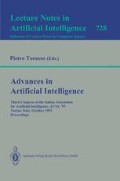Abstract
Neural architectures may offer an adequate way to deal with early vision since they are able to learn shape features or classify unknown shapes, generalising the features of a few meaningful examples, with a low computational cost after the training phase. Two different neural approaches are proposed by the authors: the first one consists of a cascaded architecture made up by a first stage named BWE (Boundary Webs Extractor) which is aimed to extract a brightness gradient map from the image, followed by a backpropagation network that estimates the geometric parameters of the object parts present in the perceived scene. The second approach is based on the extraction of the boundary webs map from the image and its comparison with boundary webs maps exhaustively generated from synthetic superquadrics. A purposely defined error figure has been used to find the best match between the two kinds of maps. A functional comparison between the two systems is described and the quite satisfactory experimental results are presented.
Preview
Unable to display preview. Download preview PDF.
References
Ardizzone, E., Gaglio, S., Sorbello, F. (1989). Geometric and Conceptual Knowledge Representation within a Generative Model of Visual Perception, Journal of Intelligent and Robotic Systems, 2, 381–409.
Ardizzone, E., Chella, A., Compagno, G., Pirrone, R. (1992). An Efficient Neural Architecture Implementing the Boundary Contour System, in: Aleksander, I., Taylor, J. (Eds.) Artificial Neural Networks, 2. North-Holland, Amsterdam.
Ardizzone, E., Chella, A., Gaglio, S., Pirrone, R., Sorbello, F. (1991), A Neural Architecture for the Estimate of 3-D Shape Parameters, in: Caianiello, E. (Ed.): Parallel Architectures and Neural Networks — Fourth Italian Workshop, World Scientific Publishers, Singapore, 270–275.
Ardizzone, E., Callari, F., Chella, A., Frixione, M. (1991), An Associative Link from Geometric to Symbolic Representations in Artificial Vision, in: Ardizzone, E., Gaglio, S., Sorbello, F. (Eds.): Trends in Artificial Intelligence, Springer Verlag, Berlin, 332–341.
Ardizzone, E., Chella, A., Pirrone, R., Sorbello, F. (1991), A System Based on Neural Architectures for the Reconstruction of 3-D Shapes from Images, in: Ardizzone, E., Gaglio, S., Sorbello, F. (Eds.): Trends in Artificial Intelligence, Springer Verlag, Berlin, 302–311.
Barr, A.H. (1981). Superquadrics and Angle-Preserving Transformations, IEEE Computer Graphics and Applications, 1, 11–23.
Callari, F., Chella, A., Gaglio, S., Pirrone, R. (1992). A New Hybrid Approach to Robot Vision, in: Aleksander, I., Taylor, J. (Eds.) Artificial Neural Networks, 2. North-Holland, Amsterdam.
Grossberg, S., Mingolla, E., (1987). Neural Dynamics of Surface Perception: Boundary Webs, Illuminants, and Shape-from-Shading. Computer Vision, Graphics and Image Processing, 37, 116–165.
Hecht-Nielsen, R. (1990) Neurocomputing, Addison-Wesley, Reading, MA, USA.
Horn, B.K.P. (1986). Robot Vision. MIT Press, Cambridge, MA, USA.
Marr, D.(1982) Vision, Freeman and Co., New York.
Pentland, A.P., Perceptual Organisation And The Representation Of Natural Form, Artificial Intelligence, 28, 293–331, 1986.
Rumelhart, D.E., Hinton, G.E. & Williams, R.J., Learning Internal Representations by Error Propagation, in: Rumelhart, D. E., McClelland, J. L. (Eds) & PDP Research Group (1986), Parallel Distributed Processing, Vol. 1, MIT Press, Cambridge, MA, USA.
Terzopoulos, D., Metaxas, D., Dynamic 3D Models with Local and Global Deformations: Deformable Superquadrics, IEEE Trans. on PAMI, 13, 7, July 1991, 703–714.
Ardizzone, E., Callari, F., Chella, A., Frixione, M. (1991), An Associative Link from Geometric to Symbolic Representations in Artificial Vision, in: Ardizzone, E., Gaglio, S., Sorbello, F. (Eds.): Trends in Artificial Intelligence, Springer Verlag, Berlin, 332–341.
Author information
Authors and Affiliations
Editor information
Rights and permissions
Copyright information
© 1993 Springer-Verlag Berlin Heidelberg
About this paper
Cite this paper
Ardizzone, E., Chella, A., Pirrone, R. (1993). New systems for extracting 3-D shape information from images. In: Torasso, P. (eds) Advances in Artificial Intelligence. AI*IA 1993. Lecture Notes in Computer Science, vol 728. Springer, Berlin, Heidelberg. https://doi.org/10.1007/3-540-57292-9_44
Download citation
DOI: https://doi.org/10.1007/3-540-57292-9_44
Published:
Publisher Name: Springer, Berlin, Heidelberg
Print ISBN: 978-3-540-57292-3
Online ISBN: 978-3-540-48038-9
eBook Packages: Springer Book Archive

